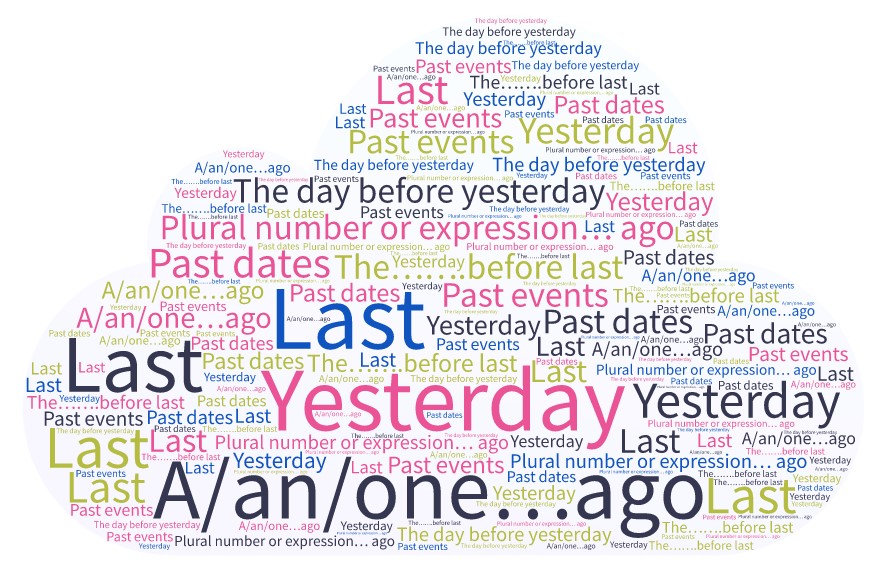

Yesterday, I wanted to go out with my friends. I was getting ready when I saw a flash of lightning on my window. This flash of lightning was so similar to the one I saw the day before that I thought a big storm was about to start.
Suddenly it started raining, so I called my friend to cancel our date. I could not go out, it was impossible and decided to stay home. I watched TV for two days.
That was my day, what about you? Can you tell me a bit?? In the city you live was it raining? Cloudy? Shiny? Stormy?

By the end of this topic you will:
• Use expressions referred to past tense (yesterday, last, etc.). You will achieve this by checking tests and different resources which reflect daily activities and lifestyle in English spoken countries.
In English, the Simple Past tense is used to talk about actions that are completed. When we mix past tenses all together, it can be challenging to identify which one we have to use. However, there are ways to make it simpler, such as using words or phrases known as time expressions.
These past tense expressions help us express actions that happened in the past as well as those that are already completed.
Click on the arrows to check the correct use of the time expressions.
Click on Word to see the meaning and click on Purpose to see some examples.
Now that you’ve already known most of the time expressions for the past, we are going to check the structure of the past tense for the sentences: affirmative and negative and the questions.
TIP: Be sure you use a comma after a time expression at the beginning of a sentence. For example: Yesterday, I went to the library.
To become familiar with the use of the expressions of time, do the following exercise.
Do this practice activity by matching the columns.
Activity 1
My cat FrühlingAs reviewed in the topic, the use of time expressions to communicate coherently, situations that happened in the past and that have already ended. In the following exercise, you will read about a conversation between a mother and her daughter. Here they talk about situations that not long ago happened in the past.
Read and choose the best options to complete the sentences. Click on Start to answer the activity by selecting the correct answer. Once you have finished, click on Send, then Finish. Finally, check your results. Remember, you can only do the task once.
Activity 2
Natural disastersUse time expressions in phrases that describe situations that happened in the past to explain the specific moment in which they occurred.
In the following exercise, you will hear audio with 5 sentences describing natural disasters that happened in the past. Click the play button to listen to the dictation. Listen carefully because you can only hear it twice.

Once you have heard the audio, click on Start to answer the exercise. You will find 5 sentences in disorder, are the same as the dictation. Choose the correct order of the words of each sentence, drag them to order and to end click on check to know your results. You can only do the exercise two times.
Activity 3
Memories...In the following activity, you are going to analyse a story written in the past tense. This means you are going to review the structures and the vocabulary explored in this unit.
The following paragraph has many mistakes. The verbs should be past tense, along with the correct expressions. Click on the word you think is wrong and write the correct one.
Activity 4
My last month...As practised in previous activities, time expressions give your conversations coherence when you talk about past situations.
In this activity, you are going to demonstrate your speaking abilities and the use of time expressions.
You are going to tell a story that happened to you. Write this story in a maximum of 150 words that describes a critical situation that happened the last month. You can use the following questions:
Then, record your audio in the free application vocaroo.com. Once the recording is completed, listen carefully. Please try to remark and pronounce the time expressions. Do not forget to use as many time expressions as you can, because your grade will depend on it. I suggest using at least 20 of these expressions.
Click on Start to evaluate your work. At the end of the activity, you will find the rubrics to assess your performance. This assessment covers grammar, vocabulary, pronunciation and fluency. You can only do the exercise once.
Now that you have finished studying the subject and that you have done all the activities, do this exercise to self-evaluate your learning by using time expressions.
Choose the most appropriate option for the following statements. Once you have finished, click on Send and finish and check your results. You can do the exercise as many times as you want.
Basic references